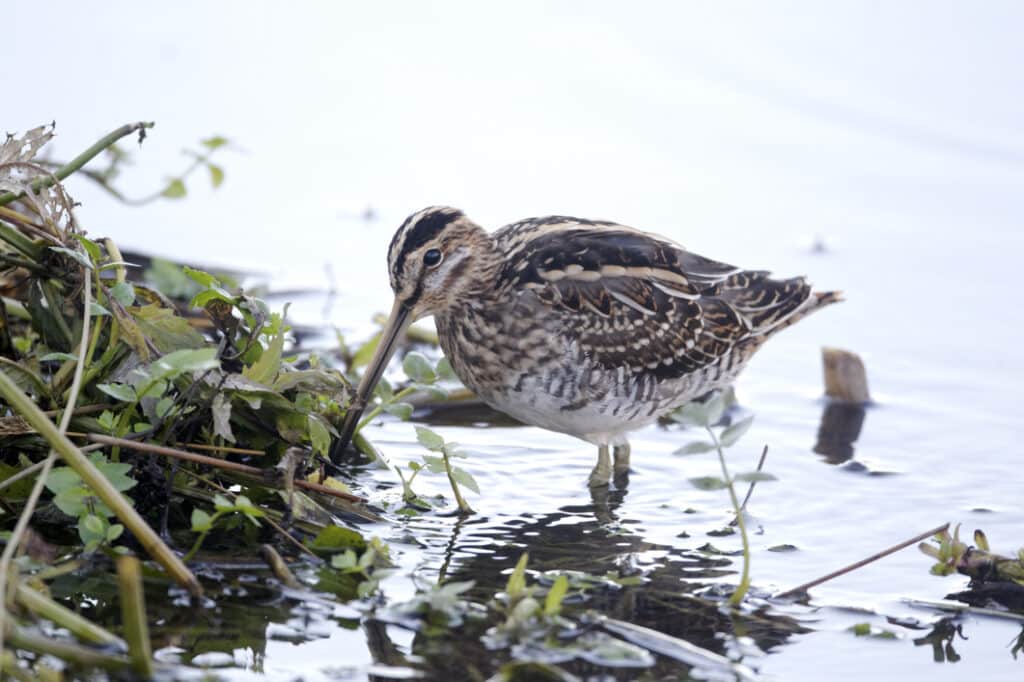Facts about the Common Snipe
Scientific name: Gallinago gallinago
Bird Family: Sandpipers, snipes and phalaropes
UK conservation status: Amber
At a glance
- Once very familiar in damp meadows, snipes have been in steep decline since 1980s.
- As part of their courtship display snipes 'drum', a sound created by the vibration of their outer tail feathers.
- Despite population declines species is still on 'quarry list' and are shot between August and January.

One of two species of snipe regularly found in the UK (and one of 28 species globally), the Common Snipe is a small wetland bird with a very long, slender bill, eyes placed high on the head for all-round vision, and cryptic/camouflaging plumage.
During the breeding season Common Snipe are best looked for in the northern uplands with lower numbers found in southern lowlands (especially south west England), when males can be heard giving their ‘drumming’ or ‘bleating’, a sound created mechanically by the vibration of their outer tail feathers as they fly in a downwards, swooping motion. In the winter, Common Snipes are more widespread, moving to the coast and to damp wetlands right across Britain and being joined by birds from northern Europe.

Once a very familiar species, huge habitat changes have seen Common Snipe disappearing across Europe since 1980.
Breeding surveys in England and Wales found a decrease of 62% in breeding birds in wet meadows between 1982 and 2002, with the remaining birds becoming highly aggregated into a tiny number of suitable sites. In Northern Ireland, the breeding population had shrunk to just 1,123 (527-1,782) pairs by 2013, representing a decrease of around 78% since 1987, with the distribution becoming increasingly fragmented.
Declines in the UK have been driven by the almost universal drainage of wet meadows and conversion into farmland that has taken place since the 1970s. However research and schemes to help improve conditions for snipes haven’t reversed the decline, and habitat quality, such as prey abundance, may also be important. Common Snipe feed mainly on earthworms, leatherjackets (crane fly larvae), beetles and caterpillars. Large areas of farmland are regularly doused in pesticides which kill vast numbers of invertebrates in the soil and the climate crisis is causing insect emergence dates to change.
Because of concerns for the future of the Common Snipe, the species was Amber-listed as a bird of conservation concern more than twenty years ago. Yet, remarkably, there is still a shooting ‘season’ for Common Snipe, which runs from August to January.
‘Countrysports enthusiasts’ appear not to have taken much notice of the reported declines in Common Snipe, and essays and adverts to shoot them are all over the internet where snipe are described as “one of our smallest and most difficult sporting targets due to its erratic flight”, their plumage “ruefully considered a special adaptation to avoid a charge of shot”, and writers penning self-serving nonsense like, “People who like snipe or woodcock hunting are first and foremost hunters who enjoy being in the habitat these birds prefer. If you can also bag an occasional bird, then your happiness is complete.”
That preferred habitat mentioned above includes nature reserves, incidentally, and shooters (with typical disregard for the feelings of anyone else) have been watched by birders sat in adjacent hides killing snipe from just outside the reserve as birds came into feed and roost.
Several petitions have been launched trying for at least a precautionary moratorium on shooting snipe (and the Red-listed Woodcock) while more data is gathered to discover what is happening to their populations. These have – without exception – been derided by shooting lobbyists, with the ‘decline’ (which is actually obvious to anyone who has been birdwatching for any length of time) being dismissed – in one case because surveys haven’t covered all habitats across all of the country.
